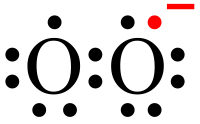
Photo from wikipedia
Through on the basis of density functional theory calculations (DFT), harmonic transition state theory and d-band center theory, the reaction mechanism and catalytic activity of Catalase, Superoxide dismutase and Peroxidase… Click to show full abstract
Through on the basis of density functional theory calculations (DFT), harmonic transition state theory and d-band center theory, the reaction mechanism and catalytic activity of Catalase, Superoxide dismutase and Peroxidase activities on the Co n Fe 3−n O 4 (n = 1–2) are systematically investigated. The results show that CoFe 2 O 4 is the most stable catalyst with the best catalytic effect. For the simulated activity of catalase, we find that the path-3 (H* and HO* → H 2 O) is the best on CoFe 2 O 4 and Co 2 FeO 4 . For the simulated activity of superoxide dismutase, the path HOO* + HOO → H 2 O 2 + O 2 is optimal on CoFe 2 O 4 and Co 2 FeO 4 . For the simulated activity of peroxidase, the mechanism on CoFe 2 O 4 and Co 2 FeO 4 is OOH* + H* → H 2 O + O*, O* + TMB → OH* + oxTMB, OH* + TMB → H 2 O + oxTMB. The results of these methods are consistent. The results thus provide an in-depth insight into the reaction mechanism and activity of Co n Fe 3−n O 4 as catalase, superoxide dismutase and peroxidase mimics and may play a role in the application of nanoparticles as mimics.
Journal Title: Catalysis Surveys from Asia
Year Published: 2020
Link to full text (if available)
Share on Social Media: Sign Up to like & get
recommendations!